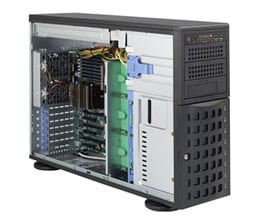So I started purchasing my equipment and in the midst of having half of it shipped to me and the other on it's way, I ran into another build possibility. A client was decommissioning their server and long story short, I was able to acquire it. The internals didn't really matter to me, I just wanted the chassis; a SUPERMICRO SuperChassis CSE-745TQ-R800B.
Please share thoughts, experience etc in regards to the two possible builds.
If I choose solution 1, then I have a future build project chassis waiting for me.
If I choose solution 2, then I can re-purpose much of what I've already purchased towards my personal PC or another future build. Or I can return it, pay for shipping and take a 15% re-stocking fee loss; not ideal and would rather just keep it.
Base components:
Intel Xeon E3 1241V3
SUPERMICRO MBD-X10SL7-F-O
Cooler Master Hyper 212 EVO
Crucial 16GB CT2KIT102472BD160B (may go to 32)
SanDisk 120GB SSD Plus
6X WD Red 4TB (maybe 8, to use 2 for offline backups)
Solution 1:
Fractal Design Node 804
Seasonic SS-660XP2 PSU
2X Noctua NF-A14 PWM 140mm Case Fan
4X Noctua NF-S12A PWM 120mm Case Fan
Solution 2:
SUPERMICRO SuperChassis CSE-745TQ-R800B includes:
OEM redundant PSUs 800W (overkill but came with the chassis)
Fans and cooling
Hot-swap bays
Sony Tape backup
Depending on cooling requirements and/or noise, they may either reside in the master bedroom closet or basement utility closet.
Please share thoughts, experience etc in regards to the two possible builds.
If I choose solution 1, then I have a future build project chassis waiting for me.
If I choose solution 2, then I can re-purpose much of what I've already purchased towards my personal PC or another future build. Or I can return it, pay for shipping and take a 15% re-stocking fee loss; not ideal and would rather just keep it.
Base components:
Intel Xeon E3 1241V3
SUPERMICRO MBD-X10SL7-F-O
Cooler Master Hyper 212 EVO
Crucial 16GB CT2KIT102472BD160B (may go to 32)
SanDisk 120GB SSD Plus
6X WD Red 4TB (maybe 8, to use 2 for offline backups)
Solution 1:
Fractal Design Node 804
Seasonic SS-660XP2 PSU
2X Noctua NF-A14 PWM 140mm Case Fan
4X Noctua NF-S12A PWM 120mm Case Fan
Solution 2:
SUPERMICRO SuperChassis CSE-745TQ-R800B includes:
OEM redundant PSUs 800W (overkill but came with the chassis)
Fans and cooling
Hot-swap bays
Sony Tape backup
Depending on cooling requirements and/or noise, they may either reside in the master bedroom closet or basement utility closet.

